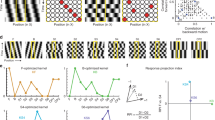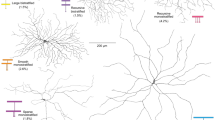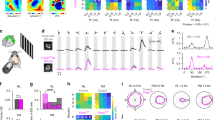Abstract
The onset of vision occurs when neural circuits in the visual cortex are immature, lacking both the full complement of connections1,2 and the response selectivity that defines functional maturity3,4. Direction-selective responses are particularly vulnerable to the effects of early visual deprivation, but it remains unclear how stimulus-driven neural activity guides the emergence of cortical direction selectivity. Here we report observations from a motion training protocol that allowed us to monitor the impact of experience on the development of direction-selective responses in visually naive ferrets. Using intrinsic signal imaging techniques, we found that training with a single axis of motion induced the rapid emergence of direction columns that were confined to cortical regions preferentially activated by the training stimulus. Using two-photon calcium imaging techniques, we found that single neurons in visually naive animals exhibited weak directional biases and lacked the strong local coherence in the spatial organization of direction preference that was evident in mature animals. Training with a moving stimulus, but not with a flashed stimulus, strengthened the direction-selective responses of individual neurons and preferentially reversed the direction biases of neurons that deviated from their neighbours. Both effects contributed to an increase in local coherence. We conclude that early experience with moving visual stimuli drives the rapid emergence of direction-selective responses in the visual cortex.
This is a preview of subscription content, access via your institution
Access options
Subscribe to this journal
Receive 51 print issues and online access
$199.00 per year
only $3.90 per issue
Buy this article
- Purchase on Springer Link
- Instant access to full article PDF
Prices may be subject to local taxes which are calculated during checkout




Similar content being viewed by others
References
Bourgeois, J. P. & Rakic, P. Changes of synaptic density in the primary visual cortex of the macaque monkey from fetal to adult stage. J. Neurosci. 13, 2801–2820 (1993)
Durack, J. C. & Katz, L. C. Development of horizontal projections in layer 2/3 of ferret visual cortex. Cereb. Cortex 6, 178–183 (1996)
Li, Y., Fitzpatrick, D. & White, L. E. The development of direction selectivity in ferret visual cortex requires early visual experience. Nature Neurosci. 9, 676–681 (2006)
White, L. E. & Fitzpatrick, D. Vision and cortical map development. Neuron 56, 327–338 (2007)
Hubel, D. H. & Wiesel, T. N. Receptive fields, binocular interaction and functional architecture in the cat’s visual cortex. J. Physiol. (Lond.) 160, 106–154 (1962)
Shmuel, A. & Grinvald, A. Functional organization for direction of motion and its relationship to orientation maps in cat area 18. J. Neurosci. 16, 6945–6964 (1996)
Weliky, M., Bosking, W. H. & Fitzpatrick, D. A systematic map of direction preference in primary visual cortex. Nature 379, 725–728 (1996)
Zhou, Y., Leventhal, A. G. & Thompson, K. G. Visual deprivation does not affect the orientation and direction sensitivity of relay cells in the lateral geniculate nucleus of the cat. J. Neurosci. 15, 689–698 (1995)
Tavazoie, S. F. & Reid, R. C. Diverse receptive fields in the lateral geniculate nucleus during thalamocortical development. Nature Neurosci. 3, 608–616 (2000)
Krug, K., Akerman, C. J. & Thompson, I. D. Responses of neurons in neonatal cortex and thalamus to patterned visual stimulation through the naturally closed lids. J. Neurophysiol. 85, 1436–1443 (2001)
Hubel, D. H. & Wiesel, T. N. Receptive fields of single neurones in the cat’s striate cortex. J. Physiol. (Lond.) 148, 574–591 (1959)
Cai, D., DeAngelis, G. C. & Freeman, R. D. Spatiotemporal receptive field organization in the lateral geniculate nucleus of cats and kittens. J. Neurophysiol. 78, 1045–1061 (1997)
Stosiek, C., Garaschuk, O., Holthoff, K. & Konnerth, A. In vivo two-photon calcium imaging of neuronal networks. Proc. Natl Acad. Sci. USA 100, 7319–7324 (2003)
Ohki, K., Chung, S., Ch’ng, Y. H., Kara, P. & Reid, R. C. Functional imaging with cellular resolution reveals precise micro-architecture in visual cortex. Nature 433, 597–603 (2005)
Bi, G. Q. & Poo, M. M. Synaptic modifications in cultured hippocampal neurons: dependence on spike timing, synaptic strength, and postsynaptic cell type. J. Neurosci. 18, 10464–10472 (1998)
Song, S., Miller, K. D. & Abbott, L. F. Competitive Hebbian learning through spike-timing-dependent synaptic plasticity. Nature Neurosci. 3, 919–926 (2000)
Sengpiel, F., Stawinski, P. & Bonhoeffer, T. Influence of experience on orientation maps in cat visual cortex. Nature Neurosci. 2, 727–732 (1999)
Schuett, S., Bonhoeffer, T. & Hubener, M. Pairing-induced changes of orientation maps in cat visual cortex. Neuron 32, 325–337 (2001)
Engert, F., Tao, H. W., Zhang, L. I. & Poo, M. M. Moving visual stimuli rapidly induce direction sensitivity of developing tectal neurons. Nature 419, 470–475 (2002)
Mu, Y. & Poo, M. M. Spike timing-dependent LTP/LTD mediates visual experience-dependent plasticity in a developing retinotectal system. Neuron 50, 115–125 (2006)
Meliza, C. D. & Dan, Y. Receptive-field modification in rat visual cortex induced by paired visual stimulation and single-cell spiking. Neuron 49, 183–189 (2006)
Yao, H., Shi, L., Han, F., Gao, H. & Dan, Y. Rapid learning in cortical coding of visual scenes. Nature Neurosci. 10, 772–778 (2007)
Tanaka, S., Ribot, J., Imamura, K. & Tani, T. Orientation-restricted continuous visual exposure induces marked reorganization of orientation maps in early life. Neuroimage 30, 462–477 (2006)
Daw, N. W., Berman, N. E. & Ariel, M. Interaction of critical periods in the visual cortex of kittens. Science 199, 565–567 (1978)
Blakemore, C. & Van Sluyters, R. C. Innate and environmental factors in the development of the kitten’s visual cortex. J. Physiol. (Lond.) 248, 663–716 (1975)
Akerman, C. J., Smyth, D. & Thompson, I. D. Visual experience before eye-opening and the development of the retinogeniculate pathway. Neuron 36, 869–879 (2002)
Chiu, C. & Weliky, M. Spontaneous activity in developing ferret visual cortex in vivo . J. Neurosci. 21, 8906–8914 (2001)
Huberman, A. D., Speer, C. M. & Chapman, B. Spontaneous retinal activity mediates development of ocular dominance columns and binocular receptive fields in v1. Neuron 52, 247–254 (2006)
Crowley, J. C. & Katz, L. C. Early development of ocular dominance columns. Science 290, 1321–1324 (2000)
Kawasaki, H., Crowley, J. C., Livesey, F. J. & Katz, L. C. Molecular organization of the ferret visual thalamus. J. Neurosci. 24, 9962–9970 (2004)
Acknowledgements
The authors thank P. Kara, T. Mrsic-Flogel and A. Kerlin for help with two-photon imaging techniques, T. Tucker and J. Heiner for technical assistance and M. Christensson and the members of the Fitzpatrick lab for comments on the manuscript. This work was supported by grants from the Whitehall Foundation to L.E.W. and the US National Institutes of Health to D.F. and S.D.V.H.
Author Contributions Y.L. performed intrinsic imaging experiments and analysis. Y.L. and S.D.V.H. performed two-photon experiments, and S.D.V.H., Y.L. and M.M. analyzed the two-photon data. Y.L., S.D.V.H., L.E.W. and D.F. wrote the paper, and all authors discussed the results and commented on the manuscript.
Author information
Authors and Affiliations
Corresponding author
Supplementary information
Supplementary Information
This file contains Supplementary Methods, Supplementary Figures and Observations S1-S7 and Supplementary References (PDF 2252 kb)
Rights and permissions
About this article
Cite this article
Li, Y., Van Hooser, S., Mazurek, M. et al. Experience with moving visual stimuli drives the early development of cortical direction selectivity. Nature 456, 952–956 (2008). https://doi.org/10.1038/nature07417
Received:
Accepted:
Published:
Issue Date:
DOI: https://doi.org/10.1038/nature07417
This article is cited by
-
Development of visual response selectivity in cortical GABAergic interneurons
Nature Communications (2022)
-
Temporal stability of stimulus representation increases along rodent visual cortical hierarchies
Nature Communications (2021)
-
Portrait of visual cortical circuits for generating neural oscillation dynamics
Cognitive Neurodynamics (2021)
-
An early phase of instructive plasticity before the typical onset of sensory experience
Nature Communications (2020)
-
Three-photon imaging of synthetic dyes in deep layers of the neocortex
Scientific Reports (2020)
Comments
By submitting a comment you agree to abide by our Terms and Community Guidelines. If you find something abusive or that does not comply with our terms or guidelines please flag it as inappropriate.



